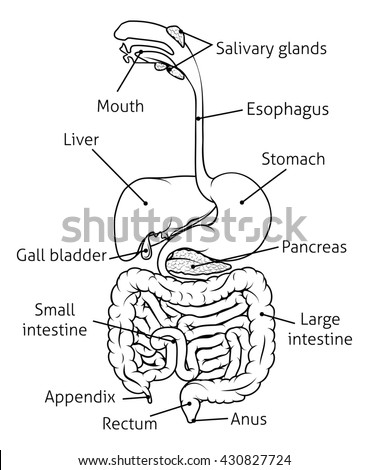with the help of well labelled diagram explain alimentary canal of human being.

Digestion
All the parts of the body involved in the uptake and digestion of food along with the elimination of undigested material constitute the digestive system.
Human Digestive System
Human digestive tract, also known as alimentary canal is a muscular tube which extends from the mouth to the anus. The parts of the digestive system include – mouth, oral cavity, teeth, oesophagus,pharynx, stomach, small intestine, large intestine and anus.
Mouth
Mouth is the opening through which intake of food occurs.
Oral cavity
The oral cavity has three parts –palate, tongue and teeth.
Palate-It forms the roof of the oral cavity. Anterior part is called hard palate and the posterior part is called soft palate.
Tongue-Tongue is a muscular and glandular structure attached to the base of the oral cavity. On the upper surface it has a V- shaped furrow called sulcusterminalis. It divides the tongue into the anterior oral partand posterior pharyngeal part. Its upper surface also consists of tiny projections called lingual papillae. Lingual papillae are of three kinds in humans-
(i)Vallate or circumvallate papillae -have gustatory receptors to sense taste
(ii) Filliform papillae– smallest and contain touch receptors.
(iii) Fungi-form papillae– Rounded and mostly present at the tip of the tongue.
Teeth-Humans are diphyodont i.e. they have two sets of teeth- milk or deciduous and permanent teeth. Humans are also heterodont, having different types of teeth.
Pharynx
It forms the common passage for food and air.
Oesophagus
It is a muscular tube through which small bolus of food passes from the mouth to the stomach. It is sharply bent at the point at which it meets the stomach. This prevents the backward movement of food from the stomach into it. Food in the digestive tract moves by an involuntary movement of alternate contraction and relaxation of muscles called peristalsis.
Stomach
It is a muscular bag which has three parts- cardiac part, fundus and body.
Cardiac part– It is so called because it is present close to the heart. The opening of oesophagus to the stomach is regulated by the cardiac sphincter.
Fundus– It is dome shaped and is usually filled with air.
Body– This is the main part of the stomach. The opening of the stomach into small intestine is regulated by the pyloric sphincter.
Small Intestine
It is the longest part of the alimentary canal and comprises three parts- Duodenum, Jejunum and Ileum.
Duodenum– It is C- shaped and receives the hepatopancreatic duct formed by the union of bile and pancreatic duct.
Jejunum– Middle part of small intestine with thick walls and more vasculature.
Ileum- Lower part of the small intestine with thin walls and less vasculature.
Large Intestine
The small intestine leads into the large intestine which has three parts- Caecum, Colon and Rectum.
Caecum– It is a small sac- like structure at the point where the small intestine meets the large intestine.
Colon– It is divided into four regions- ascending colon, tranverse colon, descending colon and sigmoid colon.
Rectum– It opens into the anus.
Hope it helps.. :)


